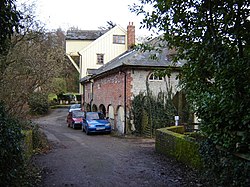Neatham
| Neatham | |
| Hampshire | |
|---|---|
 Neatham Mill | |
| Location | |
| Grid reference: | SU741408 |
| Location: | 51°9’41"N, 0°56’30"W |
| Data | |
| Post town: | Alton |
| Postcode: | GU34 |
| Dialling code: | 01420 |
| Local Government | |
| Council: | East Hampshire |
| Parliamentary constituency: |
Alton |
Neatham is a hamlet with Roman origins in the east of Hampshire. Its nearest town is Alton,(where the 2011 Census population was included) which is a mile and a half to the south-west of this hamlet.
History
The lost Roman settlement of Vindomis is believed to be at Neatham. Its strategic importance lay in its being at the crossing of important roads: one from Winchester towards London and the other from Chichester to Calleva Atrebatum (Silchester), a large Roman town to the north of present-day Basingstoke. The name Vindomis might be translated as ‘(The mansio) of the wine country’, although this may equally be a Celtic name, with the prefix VINDO meaning 'white'. Vindomis may well have been the administrative centre of a large estate associated with the potteries.[1] The population at this time is estimated at have been 2,500.
An Anglo-Saxon village grew up here, named neat ham ('ox homestead'), indicating the presence of a cattle market. For several centuries, Neatham remained the chief place in the area and the focal point of Neatham Hundred, which includes a large part of north-east Hampshire.
At the time of the Domesday Book in 1085, Neatham was recorded as belonging to the Crown and it included 96 households. Neatham Hundred included 24 other places.[2] After the founding of Waverley Abbey in 1128, King Steven made a gift of Neatham for the Abbey to establish a Grange and an Oratory, with a community of 12 monks, independent of the parish of Holybourne. Eventually, Neatham was eclipsed by Alton and, in the 12th century, the area was renamed the Alton Hundred.
When Henry VIII dissolved the monasteries, Neatham went into lay hands and became part of the parish of Binsted.
About the village
A number of historic buildings stand in Neatham including Neatham Grange, mill (including Upper Neatham Mill and Neatham Mill), dovecotes of the 18th century and the 16th or 17th century, and Neatham Manor, the Georgian manor house.
Outside links
| ("Wikimedia Commons" has material about Neatham) |